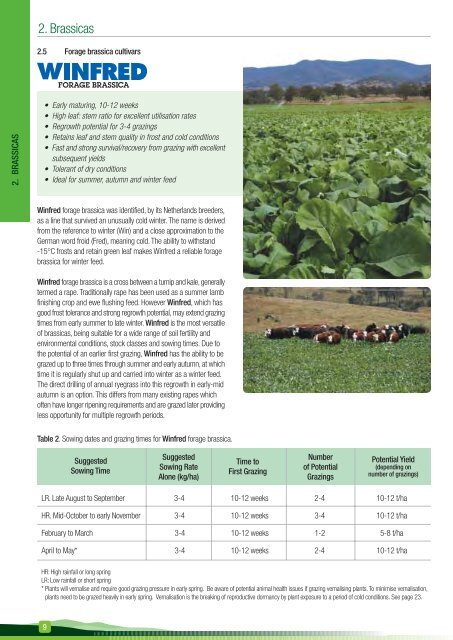Brassica Reference Manual - Agricom
Brassica Reference Manual - Agricom
Brassica Reference Manual - Agricom
You also want an ePaper? Increase the reach of your titles
YUMPU automatically turns print PDFs into web optimized ePapers that Google loves.
2. BRASSICAS<br />
2. <strong>Brassica</strong>s<br />
2.5 Forage brassica cultivars<br />
Winfred forage brassica was identified, by its Netherlands breeders,<br />
as a line that survived an unusually cold winter. The name is derived<br />
from the reference to winter (Win) and a close approximation to the<br />
German word froid (Fred), meaning cold. The ability to withstand<br />
-15°C frosts and retain green leaf makes Winfred a reliable forage<br />
brassica for winter feed.<br />
Winfred forage brassica is a cross between a turnip and kale, generally<br />
termed a rape. Traditionally rape has been used as a summer lamb<br />
finishing crop and ewe flushing feed. However Winfred, which has<br />
good frost tolerance and strong regrowth potential, may extend grazing<br />
times from early summer to late winter. Winfred is the most versatile<br />
of brassicas, being suitable for a wide range of soil fertility and<br />
environmental conditions, stock classes and sowing times. Due to<br />
the potential of an earlier first grazing, Winfred has the ability to be<br />
grazed up to three times through summer and early autumn, at which<br />
time it is regularly shut up and carried into winter as a winter feed.<br />
The direct drilling of annual ryegrass into this regrowth in early-mid<br />
autumn is an option. This differs from many existing rapes which<br />
often have longer ripening requirements and are grazed later providing<br />
less opportunity for multiple regrowth periods.<br />
Table 2. Sowing dates and grazing times for Winfred forage brassica.<br />
HR: High rainfall or long spring<br />
LR: Low rainfall or short spring<br />
* Plants will vernalise and require good grazing pressure in early spring. Be aware of potential animal health issues if grazing vernalising plants. To minimise vernalisation,<br />
plants need to be grazed heavily in early spring. Vernalisation is the breaking of reproductive dormancy by plant exposure to a period of cold conditions. See page 23.<br />
9<br />
Suggested<br />
Sowing Time<br />
Suggested<br />
Sowing Rate<br />
Alone (kg/ha)<br />
Time to<br />
First Grazing<br />
Number<br />
of Potential<br />
Grazings<br />
Potential Yield<br />
(depending on<br />
number of grazings)<br />
LR. Late August to September 3-4 10-12 weeks 2-4 10-12 t/ha<br />
HR. Mid-October to early November 3-4 10-12 weeks 3-4 10-12 t/ha<br />
February to March 3-4 10-12 weeks 1-2 5-8 t/ha<br />
April to May* 3-4 10-12 weeks 2-4 10-12 t/ha


